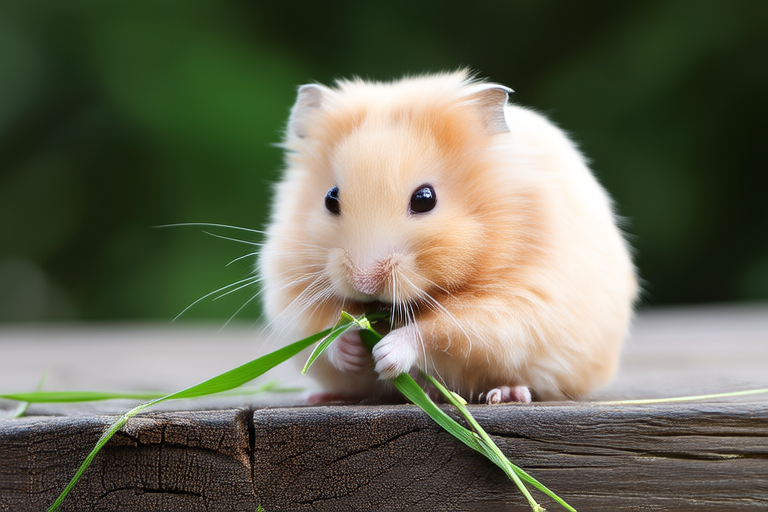Top Secrets to Keeping Your Golden Hamster Happy and Healthy
Welcome to the wonderful world of golden hamster ownership! These small, furry creatures are popular pets due to their cute appearance and relatively low maintenance. However, keeping your golden hamster happy and healthy requires attention to several key areas: diet, exercise, habitat enrichment, hygiene, social needs, and recognizing signs of illness. This guide will provide you with essential tips and scientific insights to ensure your hamster thrives.
Diet: The Foundation of Health
Golden hamsters have specific dietary requirements that must be met to maintain their health. Their diet should consist primarily of commercial hamster pellets, which provide a balanced mix of nutrients. Additionally, fresh vegetables like carrots, broccoli, and bell peppers can be offered in moderation. Be cautious with fruits, as they are high in sugar and should be given sparingly.
It’s important to avoid feeding your hamster certain foods that can be harmful. Chocolate, caffeine, and avocado are toxic to hamsters and should never be included in their diet. Scientifically, hamsters are omnivores, meaning they need both plant and animal proteins. Therefore, offering occasional treats such as mealworms or boiled eggs can provide necessary protein.
Exercise: Vital for Physical Well-being
Physical activity is crucial for a golden hamster’s overall health. In the wild, these animals cover long distances, digging and foraging. In captivity, it’s vital to provide ample opportunities for exercise. A running wheel is a popular choice, but it should be solid-surfaced to prevent injuries. Other toys, such as tunnels and chew toys, can also encourage physical activity.
Hamsters are nocturnal, meaning they are most active during the night. This behavior is linked to their circadian rhythms, which help regulate their sleep-wake cycles. To accommodate this, ensure your hamster has a quiet, dark environment during the day to rest and a stimulating one at night for playtime.
Habitat Enrichment: Creating a Stimulating Environment
A well-designed habitat can significantly enhance your hamster’s quality of life. Start by choosing an appropriate cage size; a minimum of 800 square inches is recommended for a single hamster. Include various levels and platforms to mimic their natural burrowing environment. Nesting materials, such as shredded paper or hay, provide comfort and aid in stress reduction.
Toys and accessories that encourage exploration and mental stimulation are essential. Hide-and-seek games with treats hidden within the cage can engage your hamster’s natural foraging instincts. Scientific research indicates that environmental enrichment can improve cognitive function and reduce stress in small mammals.
Hygiene: Maintaining Cleanliness
Maintaining good hygiene is critical for preventing illnesses. Regular cleaning of the cage is necessary to remove waste and potential pathogens. Spot clean daily, removing soiled bedding and uneaten food. Perform a thorough cleaning every few weeks, replacing all bedding and washing accessories with pet-safe disinfectants.
Hamsters are prone to dental issues due to their constantly growing teeth. Provide suitable chewing materials like wooden blocks or untreated twigs to help wear down their teeth. Additionally, ensuring proper ventilation in the cage can prevent respiratory problems.
Social Needs: Understanding Hamster Behavior
Contrary to popular belief, golden hamsters are solitary animals and typically do not thrive in the company of other hamsters. Introducing two adult hamsters often results in aggressive behavior and fighting. It’s best to keep each hamster in its own cage.
While they don’t need companionship from other hamsters, they do require interaction with their human caregivers. Spend time handling your hamster gently each day. This bonding helps reduce stress and strengthens the relationship between you and your pet. Scientific studies show that regular interaction can improve a hamster’s mood and well-being.
Signs of Illness: Early Detection is Key
Being vigilant about your hamster’s health is crucial for early intervention. Common signs of illness include lethargy, loss of appetite, unusual weight gain or loss, and changes in bathroom habits. If you notice any of these symptoms, consult a veterinarian specializing in small animals immediately.
Gastrointestinal issues are prevalent among hamsters and can be caused by improper diet or stress. Diarrhea, bloating, and refusal to eat are indicators of digestive problems. Respiratory infections, characterized by sneezing, wheezing, and discharge from the nose or eyes, are also common. Regular veterinary check-ups can help catch potential health issues before they become severe.
Conclusion: Your Role in Hamster Care
Caring for a golden hamster involves more than just providing food and water. By understanding their dietary needs, ensuring adequate exercise, enriching their habitat, maintaining hygiene, addressing social needs, and being aware of signs of illness, you can contribute to your hamster’s happiness and longevity.
We hope this guide has provided valuable insights into keeping your golden hamster happy and healthy. Share your own experiences or ask questions in the comments below. Together, we can learn and grow in our journey of responsible pet ownership.
